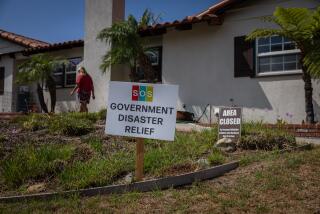Pomona Will Spend $1 Million on New Disaster Equipment
POMONA â Conceding that the Upland earthquake two weeks ago caught the city unprepared, Pomona officials have decided to buy up to $1 million worth of disaster equipment and supplies.
âThe lesson to be learned from the Feb. 28 earthquake is that as a city and an emergency response provider, we are ill-equipped to provide an acceptable minimum level of assistance,â Fire Chief Thomas Fee and four other department heads said in a report submitted to the City Council this week.
The officials said the city has under-funded its emergency services program, has failed to test its procedures and has neglected to train its departments and community agencies to work together during a disaster.
Fee said that employees sent to inspect earthquake damage two weeks ago could not communicate back to their superiors because the city didnât have enough hand-held radios.
The lack of communications equipment was not a severe problem in this earthquake, Fee said, because the damage was not heavy. But in a larger disaster, where the city would enlist the aid of volunteers and send many crews into the field, the lack of communications equipment could interfere with rescue efforts, he said.
Another shortcoming is a lack of portable generators, Fee said. In the event of a power failure, the city public safety complex has an emergency generator that would keep it operating, but the city doesnât have portable generators to pump sewage and water or handle other emergencies.
Fee said the cityâs store of emergency supplies has consisted of some food and cots that were put in the basement of the City Hall, library and police buildings in 1968. The cots have rotted away, he said, and the foodâs shelf life has expired.
City Administrator Julio Fuentes recommended this week that the city borrow $1 million from its water fund reserves to pay for a long list of equipment. The council approved the request, but some members questioned whether all the requested equipment is necessary.
Councilman C. L. (Clay) Bryant said he doubts that the Police Department needs the all-terrain vehicle it requested. Other items that might be eliminated, he said, include half a dozen computers and five fax machines.
Fuentes said he would review the list again and submit justification for any items that had been questioned.
The city is planning to construct an emergency command center along with a fire training facility at its fire station on Temple Avenue at the western edge of the city.
The proposal approved by the council this week would provide $167,000 in communications equipment for the command center and $62,300 for a trailer and equipment for a mobile field command center.
Other items to be acquired are more than 50 hand-held radios, nine portable generators, 30 tents and a long list of rescue items ranging from sledgehammers to floodlights to safety goggles.
Other cities in the San Gabriel Valley have been increasing their disaster preparedness since the 1987 Whittier earthquake.
El Monte hired an emergency preparedness coordinator after the Whittier quake and provided each city department with a portable generator and an emergency aid kit, said police Lt. Bill Ankeny.
In West Covina, money is allocated each year to build up the cityâs supply of flashlights, food, first aid kits and other supplies. The city also has emergency purchase orders with local businesses in case it needs more equipment, said Sharon Gardner, an administrative analyst in West Covinaâs emergency preparedness office.
Alhambra has not set aside money for emergency food and services, but it has purchased communications equipment and vehicles that could be used in case of an earthquake.
Los Angeles county officials are conducting a five-year study to improve earthquake preparedness, including obtaining emergency equipment for unincorporated areas. The plan, implemented in 1987, also lists cities and communities with surpluses or deficiencies so officials will know where to turn for help during a disaster.
More to Read
Sign up for Essential California
The most important California stories and recommendations in your inbox every morning.
You may occasionally receive promotional content from the Los Angeles Times.










